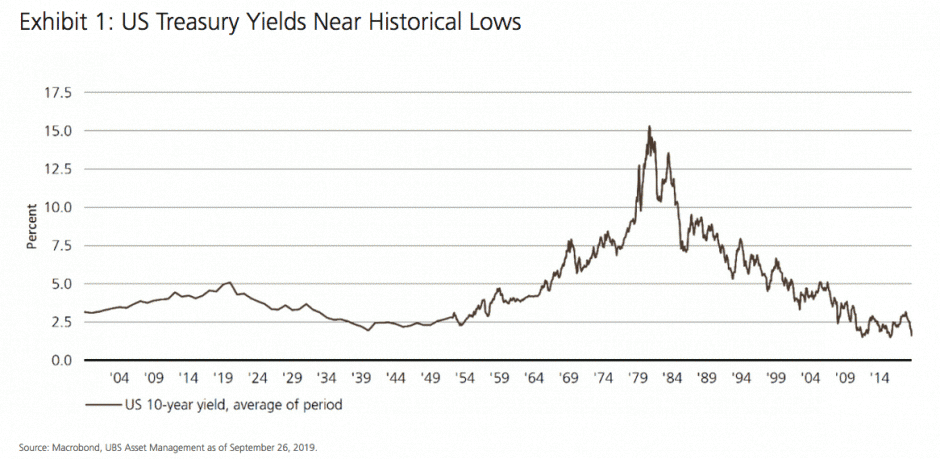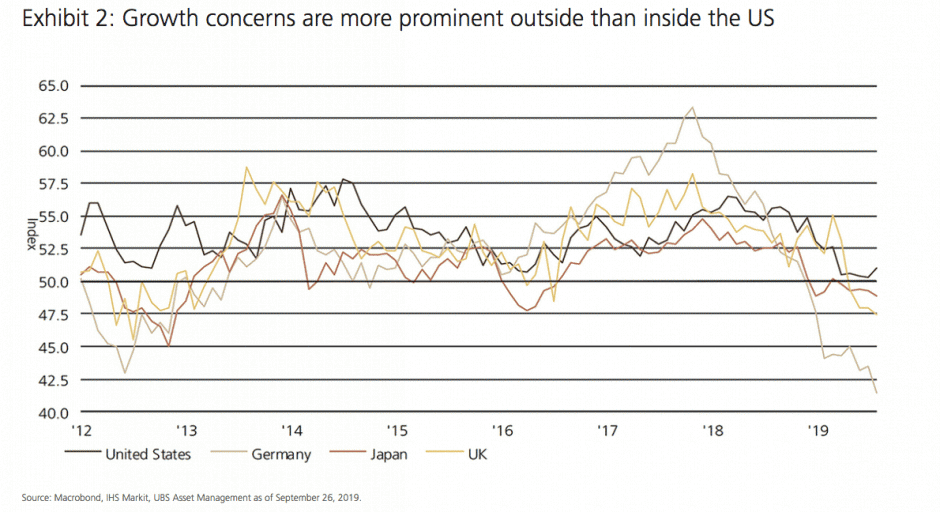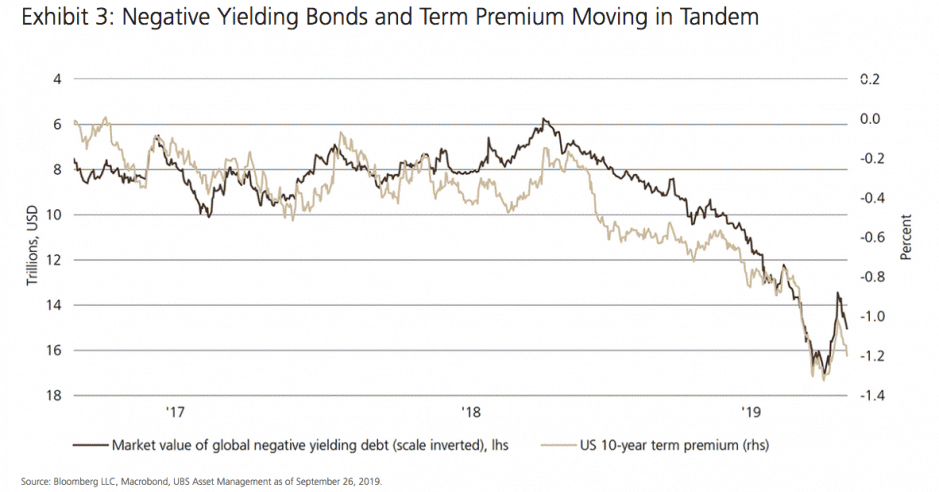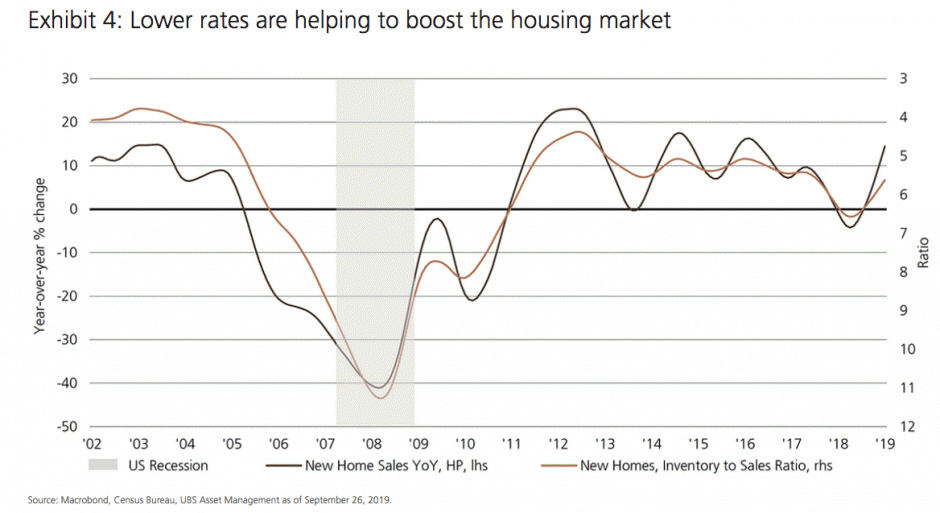
UBS: US Treasuries – Overvalued but valuable
This edition of Macro Monthly discusses what low rates are currently signaling, where we go from here and the value of Treasuries in a multi-asset portfolio despite their historical overvaluation.
02.10.2019 | 09:20 Uhr
US Treasuries: Overvalued but valuable
- US Treasuries are historically expensive, reflecting low growth, inflation and rate expectations. But a significant driver of low yields is the compression of term premium, reflecting in large part extraordinarily accommodative policy outside the US.
- After the September European Central Bank (ECB) meeting, it is clear that negative yielding debt will be a feature of the market environment for the foreseeable future. And the scarcity of positive yielding, defensive assets is an uncomfortable reality for investors.
- A brighter cyclical backdrop, evidenced by a genuine bottoming in the growth outlook and/or a trade breakthrough can drive some normalization of bond valuations. But a true break in the nearly 40-year downtrend in bond yields will likely require a significant increase in fiscal expansion.
- Even with historically rich valuations, we view US Treasuries as attractive in the context of a multi-asset portfolio. Geopolitical risks have become a core driver of economies and markets, are inherently unpredictable and illustrate the need for downside protection.
A lot can change in a year. In the autumn of 2018, the US-10 year Treasury yield reached just shy of 3.25%; by August 26, 2019 it had fallen to 1.45%. While off their troughs, bond yields remain unquestionably low on a historical basis (Exhibit 1). What happened? There are three main catalysts in our view: a significant slowdown in global growth, central banks shifting from tightening to easing and a flight to safety as markets scrambled to price in downside risks of trade conflict. This Macro Monthly discusses what low rates are currently signaling, where we go from here and the value of Treasuries in a multi-asset portfolio despite their historical overvaluation

Interpreting the term premium
Long-term interest rates can be broken down into two components—rate expectations and term premium, or the compensation investors demand for taking interest rate risk further out the curve. Certainly rate expectations have come down, as the Fed has eased and markets have re-assessed the long term path of Fed policy. But a significant portion of the decline, and much of what has driven interest rate volatility of late has been the term premium.
In our view, the term premium has been driven more by economic and policy developments outside of the US than within it. Global growth has decelerated more in Europe and Japan than in the US. Moreover, central banks like the ECB have driven rates further into negative territory and extended quantitative easing programs. The ECB’s forward guidance has tied negative rates and QE to the inflation outlook—with little evidence that core inflation is moving higher, negative yielding debt is likely to be a feature of global financial markets for the foreseeable future.

As global financial markets are integrated, investors facing negative yields are incentivized to look for positive yielding alternatives. There is a scarcity of positive yielding defensive assets in the world, so global capital piles into what’s remaining. Exhibit 3 shows how the term premium on US Treasuries has tracked the sharp rise in negative yielding debt globally.

What can drive yields higher?
What this suggests is that to have further bounce in bond yields beyond what we saw in the first half of September, there must be some convincing healing in the global economic outlook. The leading economic indicators we track are mixed and at this point show only tentative stabilization in the global economy. A genuine and sustained ceasefire in the US-China trade war would clearly help, and likely be enough to drive US 10-year yields back above 2%.
But the forces behind the long-term downward trend in bond yields will not disappear overnight. Slowing demographics, higher desired saving than investment, low inflation and inflation expectations are structural headwinds, which can only be countered by a powerful change in the macro-economy. One possibility is a surge in productivity though it is difficult to see this in the near term given the slowdown in investment linked to the trade war. But productivity is notoriously difficult to forecast and we can’t rule out a technology-driven game changer.
More likely is a global surge in the use of fiscal policy to support the economy, such as a sharp increase in infrastructure spending. Such policy would drive bond yields higher via the growth channel and increased bond issuance. This, ultimately, is how we’d expect policymakers to lift their economies out of the next recession, especially given less room to ease monetary policy than in prior cycles. But policymakers seem hesitant to deliver proactive as opposed to reactive stimulus, as evidenced by modest changes in policy in Germany and China’s hesitance to launch all-out stimulus. We remain on watch for political dynamics to change on this front, such as a large shift towards progressives in the US, but for now it seems the sequencing is recession first, aggressive fiscal stimulus second.
The plus side
The good news for now is that, at least in the US, the low bond yields we’ve discussed look enough to cushion the economy from a major downturn, in our view. Amid much lower mortgage rates, the US housing market is staging a healthy rebound. It is not easy for the household-driven US economy to fall into recession with the housing market itself in an upcycle.

So where do we stand? We still hold the base case view that the global economy will be able to stabilize around its trend rate, as prior monetary stimulus gains traction in the economy. This suggests some modest upside to yields. Nevertheless, downside risks associated with trade conflicts remain and the scarcity of positive yielding safe assets make US Treasuries important diversifiers in a multi-asset context, even if the yields on offer are less attractive than historically.
The Bottom Line: Asset allocation
Within fixed income we find US Treasuries attractive, especially relative to negative yielding debt abroad. In a low rate and low (but not recessionary) growth world we also like emerging market debt, including relatively high yielding Chinese bonds. The still tentative state of the global economy and ongoing trade conflicts keep us broadly neutral on equities, though we continue to see value in Japanese stocks which are finally gaining recognition for improved corporate governance and reform. While overvalued, the dollar remains stubbornly strong and should require clear economic stabilization outside of the US before moving convincingly lower.




Diesen Beitrag teilen: